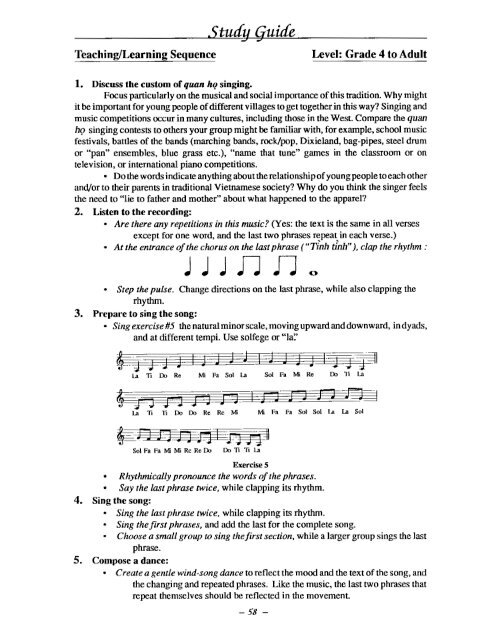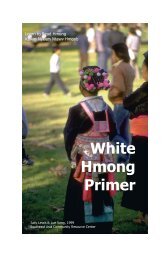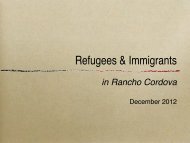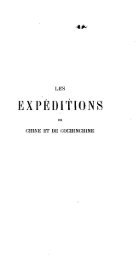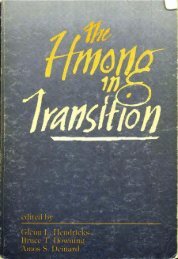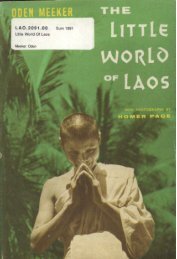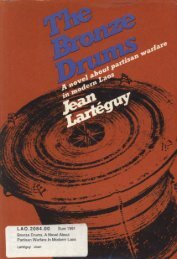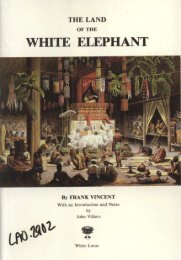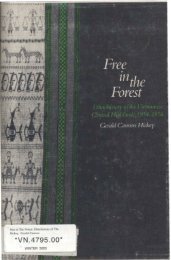and Temple Yards
iutnam From Rice Paddies and Temple Yards - Refugee Educators ...
iutnam From Rice Paddies and Temple Yards - Refugee Educators ...
- No tags were found...
You also want an ePaper? Increase the reach of your titles
YUMPU automatically turns print PDFs into web optimized ePapers that Google loves.
TeachingILearning Sequence<br />
Level: Grade 4 to Adult<br />
1. Discuss the custom of quan ho singing.<br />
Focus particularly on the musical <strong>and</strong> social importance of this tradition. Why might<br />
it be important for young people of different villages to get together in this way? Singing <strong>and</strong><br />
music competitions occur in many cultures, including those in the West. Compare the gum<br />
ho singing contests to others your group might be familiar with, for example, school music<br />
festivals, battles of the b<strong>and</strong>s (marching b<strong>and</strong>s, rocklpop, Dixiel<strong>and</strong>, bag-pipes, steel drum<br />
or "pan" ensembles, blue grass etc.), "name that tune" games in the classroom or on<br />
television, or international piano competitions.<br />
Do the words indicate anything about the relationship of young people to each other<br />
<strong>and</strong>lor to their parents in traditional Vietnamese society? Why do you think the singer feels<br />
the need to "lie to father <strong>and</strong> mother" about what happened to the apparel?<br />
2. Listen to the recording:<br />
Are there any repetitions in this music? (Yes: the text is the same in all verses<br />
except for one word, <strong>and</strong> the last two phrases repeat in each verse.)<br />
At the entrunce of the chorus on the lust phrase ("~inh 6nhw), clap the rhythm :<br />
Step the pulse. Change directions on the last phrase, while also clapping the<br />
rhythm.<br />
3. Prepare to sing the song:<br />
Sing exercise #5 the natural minor scale, moving upward <strong>and</strong> downward, in dyads,<br />
<strong>and</strong> at different tempi. Use solfege or "la:'<br />
La 'li Do Re Mi Fa Sol La Sol Fa Mi Re Do li La<br />
La 'li li Do Do Ke Re Mi Mi Fa Fa Sol Sol Ir La Sol<br />
Sol Fa Fa Mi Mi Rc Ke Do<br />
Do Ti li La<br />
Exercise 5<br />
Rhythmically pronounce the words of the phrases.<br />
Say the last phrase twice, while clapping its rhythm.<br />
4. Sing the song:<br />
Sing the last phrase twice, while clapping its rhythm.<br />
Sing thefirst phrases, <strong>and</strong> add the last for the complete song.<br />
Choose a small group to sing the first section, while a larger group sings the last<br />
phrase.<br />
5. Compose a dance:<br />
Create a gentle wind-song dance to reflect the mood <strong>and</strong> the text of the song, <strong>and</strong><br />
the changing <strong>and</strong> repeated phrases. Like the music, the last two phrases that<br />
repeat themselves should be reflected in the movement.


